Title: AGN feedback in dwarf galaxies?
Authors: Gohar Dashyan, Joseph Silk, Gary A. Mamon, Yohan Dubois, Tilman Hartwig
First Author’s Institution: Institut d’Astrophysique de Paris
Status: Published in MNRAS, open access on arXiv
Cosmological simulations using our best model of the Universe, ΛCDM, do a pretty good job of reproducing large-scale structure. But when you look closely, on smaller scales, things start to get complicated. Dwarf galaxies, the building blocks of larger structure, present a number of problems. Such significant problems in fact, that many of them have names (and are listed on Wikipedia’s unsolved problems in physics page). The “missing satellite problem” describes the fact that simulations predict many more dwarfs to exist around massive galaxies like the Milky Way than are actually observed. A proposed solution to this is that, while many dwarf satellites exist, only the most massive actually have enough stars to be visible. Unfortunately this gives rise to yet another challenge, dubbed the “too-big-to-fail” problem: these visible satellites would, therefore, have to be much more massive than those observed in the local group. To resolve the problem, some additional physics is required to suppress the formation of the largest dwarf galaxies.
These are just two of ten issues arising from inconsistencies between observations and simulations of dwarf galaxies that Joseph Silk lists in this somewhat speculative paper from 2017. As he remarks, there have been a multitude of proposed solutions. The majority are based on supernova-driven feedback ejecting gas from galaxies and preventing them from forming stars, but many require an uncomfortable level of fine-tuning or serendipitous environmental conditions to reproduce observations. This has prompted scientists to question the ΛCDM paradigm, asking if perhaps the prevailing model of dark matter is flawed. Silk argues to the contrary — that new fundamental physics is uncalled for, instead proposing an elegant solution that could simultaneously resolve all of these inconsistencies. This solution, a “new ingredient” in our recipe of galaxy formation, takes the form of feedback from intermediate-mass black holes (IMBHs) lurking in the hearts of dwarf galaxies.
The paper tackled in today’s astrobite is one of several more rigorous follow-ups to the ideas that Silk presented earlier. Here, the authors investigate the energetics of IMBH feedback, to find out if it is a plausible contender for that missing ingredient. Feedback in this case means the process by which the energetic output of an active galactic nucleus (AGN) — a black hole accreting matter — drives an outflow, blasting out the gas and preventing further star formation, thus shutting down the growth of the galaxy.
This paper asks how efficient AGN feedback could be in dwarf galaxies, relative to the more commonly invoked supernova-driven feedback. Could it play a significant role in shaping the dwarf galaxy population, and resolve the numerous problems? A simple model of this feedback is constructed, shown in Figure 1.
The authors define a critical halo mass, below which the AGN-driven outflow is energetic enough for the gas to escape the gravitational confines of the galaxy. Above the critical mass, the gravitational potential is too large: as the outflow propagates through the galaxy, it cools and and loses energy, and fails to exceed the escape velocity of the halo.
They then investigate how various parameters such as the duration and efficiency of the AGN activity influence this critical halo mass. Their results are summarised in Figure 2.
The point at which the critical mass is equal for AGN-driven outflows and for supernova-driven outflows is marked by the black dot-dashed line, for two different supernova efficiencies ϵw: anything to the upper-right of this line shows where AGN feedback dominates over supernovae. From observations, supernova feedback efficiency is estimated to be less than 10% — the lower dot-dashed line in this plot. By modelling the energetics of the AGN-driven outflow, they show that for almost all combinations of efficiency and duration, AGN feedback dominates over supernova feedback, driving the gas out of the galaxy. This presents a possible solution to the too-big-to-fail problem, as AGN feedback can succeed in shutting down the growth of even the most massive dwarfs, where the weaker supernova feedback struggles.
While the authors do note that this is a simplistic model — for example, they don’t try to model how supernova feedback would interact with AGN feedback, instead considering the processes independently — this is a first, exciting foray into the effects of IMBH feedback in dwarf galaxies. It’s an idea that could provide an explanation for the discrepancies between cosmological simulations and observations of dwarf galaxies, without having to modify fundamental physics. Future simulations that take into account additional complexities may reveal more about the plausibility of this solution, which can only be verified with more robust observations of IMBHs and their effects in dwarf galaxies.




